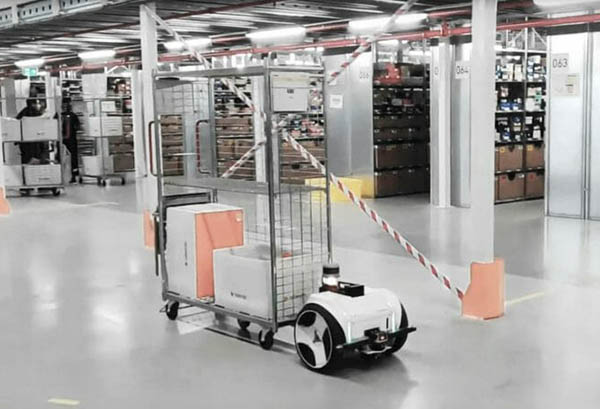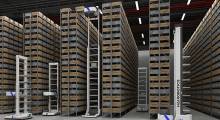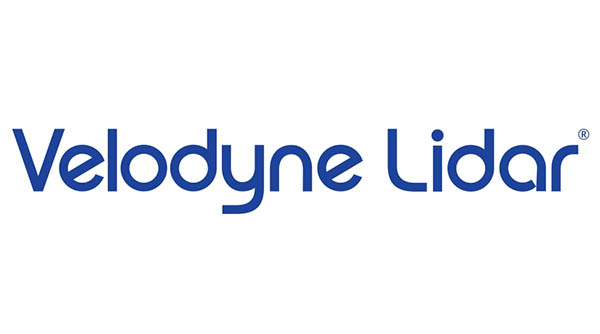Velodyne Lidar Inc. and MOV.AI today announced that they are collaborating to provide robot manufacturers with systems for mapping, navigation, obstacle avoidance, and risk avoidance. The MOV.AI Robotics Engine Platform, combined with Velodyne’s Puck lidar sensors, will meet the growing demand for automation in dynamic collaborative environments such as e-commerce, logistics, manufacturing, and hospitals, they said.
“MOV.AI’s mission is to simplify collaborative robot development and to provide AMR [autonomous mobile robot] manufacturers and integrators with everything they need to develop and operate great robots,” said Motti Kushnir, CEO of MOV.AI. “Through the collaboration with Velodyne, we are able to offer our customers advanced SLAM [simultaneous localization and mapping] navigation powered by the Puck, one of the world’s leading lidar sensors.”
“Our Robotics Engine Platform allows AMR manufacturers to quickly implement state-of-the-art navigation, while leaving them the ability to customize it to their needs,” he said.
MOV.AI builds platform on ROS
The dramatic growth of e-commerce is driving the materials handling and logistics markets, said the companies. The COVID-19 pandemic helped grow U.S. online sales to $791 billion in 2020, up 32% from the prior year, according to the U.S. Department of Commerce.
The combination of MOV.AI's Robotics Engine Platform and Velodyne’s Puck sensors will allow mobile robot makers and integrators to address the challenges of safely moving in environments such as warehouses and e-commerce fulfillment centers.
The Robotics Engine is based on the Robot Operating System (ROS) and includes an intuitive Web-based interface and tools to quickly build, deploy, and operate AMRs, said MOV.AI. The platform can help AMR manufacturers and integrators create flexible, affordable products and shorten time to market, said the Tel Aviv, Israel-based company.
The Robotics Engine Platform also includes a visual integrated development environment (IDE), off-the-shelf algorithms and integrations, and fleet management capabilites. In addition, it has interfaces for warehouse management systems (WMS) and enterprise resource planning (ERP) software, as well as cybersecurity compliance. The system provides ±2 cm accuracy for a 65% dynamic environment, said MOV.AI.
Velodyne Puck is portable for robots
In addition to helping AMR makers quickly develop and deploy robots that can operate alongside people and other machines, MOV.AI's Robotics Engine Platform can use the performance and reliability of Velodyne's Puck sensor, said the companies. This combination will allow mobile robots to move outside controlled situations and safely function in unfamiliar and unpredictable settings.
The Puck’s compact form factor enables it to be embedded easily into robots, said Velodyne. The lidar sensor can deliver high accuracy in complex indoor and outdoor environments, claimed the company.
Velodyne Lidar claimed that it invented real-time, surround-view lidar. The San Jose, Calif.-based company said its sensors and software meet the needs of autonomous vehicles, advanced driver assistance systems (ADAS), robotics, unmanned aerial vehicles (UAV), smart cities, and security.
Collaborative mobile robot market growing
“We are very excited about the collaboration with MOV.AI and integration of our lidar sensors into the Robotics Engine Platform, including future expansion to our solid-state Velarray and Velabit products,” said Erich Smidt, executive director of Europe at Velodyne Lidar. “There is a growing demand for automation and integration of our sensors into collaborative robots.”
“We see extensive potential in this space, with the global AMR market size is expected to reach USD 8.70 billion in 2028, with a CAGR [compound annual growth rate] of 23.7% from 2021 to 2028, according to Fortune Business Insights,” he added. “Partnering with MOV.AI can enable us to bring safety, efficiency and sustainability into the industrial sector on a large, global scale.”
“Adding MOV.AI and Velodyne solutions to TUGBOT.ai provided our robot with an off-the-shelf, high-accuracy navigation and localization solution for the high and dynamic environments where we are deploying our AMRs,” said Fernando Freitas, CEO of RoboSavvy, which makes the TUGBOT.ai AMR. “Using lidar-based SLAM enables TUGBOT.ai to navigate safely among people and other vehicles with accurate and consistent performance.”
Article topics
Email Sign Up

















